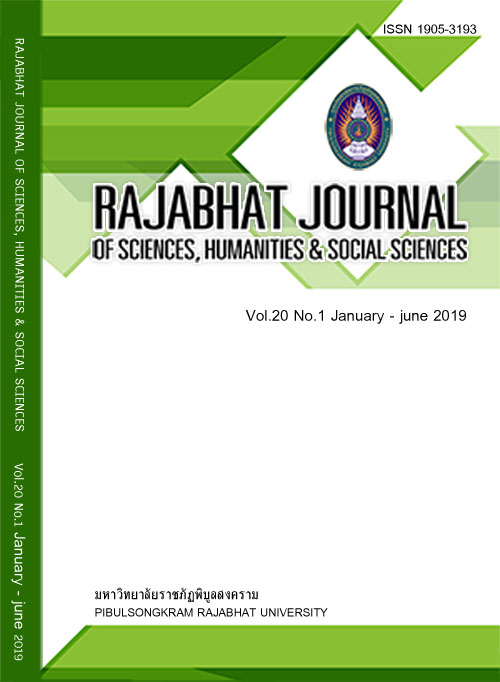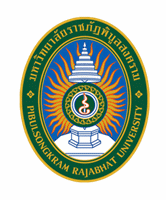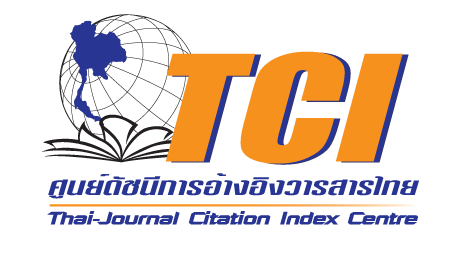การพัฒนาอาหารเชิงหน้าที่: ช็อกโกแลตนมเสริมแอนโทไซยานิน จากปลายข้าวไรซ์เบอร์รี่
คำสำคัญ:
แอนโทไซยานิน, สารต้านอนุมูลอิสระ, ช็อกโกแลต, อาหารเชิงหน้าที่, ข้าวไรซ์เบอร์รี่บทคัดย่อ
การรับประทานอาหารเชิงหน้าที่ที่มีผลดีต่อสุขภาพมากกว่าอาหารปกติ พบว่าช่วยลดความเสี่ยงต่อโรคในกลุ่มโรคไม่ติดต่อที่เป็นสาเหตุสำคัญของการเสียชีวิตจากโรคของประชากรไทย ปลายข้าว
ไรซ์เบอร์รี่เป็นผลิตภัณฑ์ผลพลอยได้ทางการเกษตรที่ถูกใช้ประโยชน์น้อยแต่มีปริมาณแอนโทไซยานินสูง
ซึ่งจัดเป็นสารต้านอนุมูลอิสระที่ป้องกันโรคดังกล่าวได้ ในงานวิจัยนี้ใช้สารสกัดปริมาณแอนโทไซยานินสูงจากปลายข้าวไรซ์เบอร์รี่เป็นส่วนผสมเชิงหน้าที่เพื่อผลิตช็อกโกแลตนมที่ดีต่อสุขภาพมากขึ้น ซึ่งผลิตโดยแทนที่ผงโกโก้ด้วยผงแอนโทไซยานิน (แอนโทไซยานินห่อหุ้มด้วยมอลโทเด็กซ์ทริน) ในปริมาณ
ร้อยละ 0 (MC0), 21 (MC21), 42 (MC42) และ 70 (MC70) โดยน้ำหนัก ปริมาณแอนโทไซยานินทั้งหมดใน MC21, MC42 และ MC70 มีค่าเพิ่มขึ้นเป็นลำดับ (11.1, 82.2 และ 107.1 mg cyanidin-3-glucoside equivalent/100 g) ตามปริมาณผงแอนโทไซยานิน แต่ตรวจไม่พบใน MC0 ส่งผลให้ฤทธิ์การต้านอนุมูลอิสระ DPPH ของ MC0, M21, MC42 และ MC70 เพิ่มขึ้นจากร้อยละ 70.7, 72.1, 74.3 ถึง 76.4 ตามลำดับ มอลโทเดกซ์ทรินซึ่งเป็นองค์ประกอบหลักในผงแอนโทไซยานินทำให้ความแข็งของช็อกโกแลตลดลงจาก 16.6 N (MC0) จนถึง 9.6 N (MC70) ช็อกโกแลต MC42 มีคะแนนทางประสาทสัมผัสสูงที่สุด (7.0-7.7) ต่อคุณลักษณะด้านสี กลิ่นรส รสชาติ เนื้อสัมผัส และการยอมรับโดยรวม
ผลการทดลองแสดงให้เห็นว่าแอนโทไซยานินสกัดจากปลายข้าวไรซ์เบอร์รี่อาจใช้เป็นส่วนผสมเชิงหน้าที่ที่มีคุณประโยชน์ต่อสุขภาพเพื่อผลิตอาหารที่ดีต่อสุขภาพมากขึ้นได้
เอกสารอ้างอิง
Aidoo RP, Afoakwa EO, Dewettinck K. Rheological properties, melting behaviours and physical quality characteristics of sugar-free chocolates processed using inulin/polydextrose bulking mixtures sweetened with stevia and thaumatin extracts. LWT - Food Science and Technology. 2015; 62: 592-597.
Castañeda-Ovando A, Pacheco-Hernández M, Páez-Hernández, et al. Chemical studies of anthocyanins:
A review. Food Chemistry. 2009; 113(4): 859-871.
Ekici L, Simsek Z, Ozturk I, et al. Effects of temperature, time, and pH on the stability of anthocyanin extracts: prediction of total anthocyanin content using nonlinear models. Food Analytical Methods. 2014; 7(6): 1328-1336.
Gallo M, Vinci G, Graziani G. et al. The interaction of cocoa polyphenols with milk proteins studied by proteomic techniques. Food Research International. 2013; 54(1): 406-415.
Giusti MM, & Wrolstad RE. Characterization and measurement of anthocyanins by UV-visible spectroscopy. Current Protocols in Food Analytical Chemistry. New Jersey: John Wiley & Sons; 2001: F1.2.1–F1.2.13.
Gültekin-Özgüven M, Karadağ A, Duman Ş. et al. Fortification of dark chocolate with spray dried black mulberry (Morus nigra) waste extract encapsulated in chitosan-coated liposomes and bioaccessability studies. Food Chemistry. 2016; 201: 205-212.
Hannaneh F, Soleiman A. Effects of inulin and bulking agents on some physicochemical, textural and sensory properties of milk chocolate. Journal of Texture Studies. 2009; 40(5): 536-553.
Hou Z, Qin P, Zhang Y, et al. Identification of anthocyanins isolated from black rice (Oryza sativa L.) and their degradation kinetics. Food Research International. 2013; 50(2): 691-697.
Kalva JJ, Sims CA, Puentes LA, et al. Comparison of the hedonic general labeled magnitude scale with the hedonic 9-point scale. Journal of Food Science. 2014; 79(2): 238-245.
Konar N. Influence of conching temperature and some bulk sweeteners on physical and rheological properties of prebiotic milk chocolate containing inulin. European Food Research and Technology. 2013; 236(1): 135-143.
Laokuldilok T, Kanha N. Effects of processing conditions on powder properties of black glutinous rice (Oryza sativa L.) bran anthocyanins produced by spray drying and freeze drying. LWT - Food Science and Technology. 2015; 64(1): 405-411.
LeongLP, Shui G. An investigation of antioxidant capacity of fruits in Singapore markets. Food Chemistry. 2002; 76(1): 69-75.
Ngamdee P, Wichai U, Jiamyangyuen S. Correlation between phytochemical and mineral contents and antioxidant activity of black glutinous rice bran, and its potential chemopreventive property. Food Technology and Biotechnology. 2016; 54(3); 282-289.
Yousuf B, Gul K, Wani AA, et al. Health benefits of anthocyanins and their encapsulation for potential use in food systems: a review. Critical Reviews in Food Science and Nutrition. 2016; 56(13): 2223-2230.
ดาวน์โหลด
เผยแพร่แล้ว
รูปแบบการอ้างอิง
ฉบับ
ประเภทบทความ
สัญญาอนุญาต
Each article is copyrighted © by its author(s) and is published under license from the author(s).










